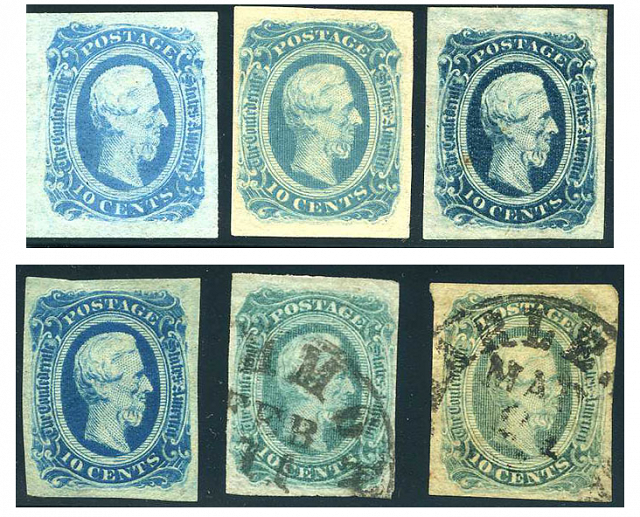Catalog Numbers are from the Confederate States of America Catalog and Handbook of Stamps and Postal History

Pick a color - any color - these issues are ripe for shade comparison studies
John Halpin designed and engraved the stamp's central motif on steel, a portrait of Jefferson Davis. The engraving was then transferred to steel printing plates. They are very similar in design to Type I, distinguished most easily by the filled-in corners, outer scrolls, and the presence of a light outer line framing the entire design.
For many years, it was believed that John's Halpin's brother Frederick had engraved these stamps but, in 2015, Halpin descendant Jeffrey Hawkins proved that it was Frederick's brother John (both were engravers) who engraved the stamps. The story of these two brothers was published in the Confederate Philatelist, the journal of the Confederate Stamp Alliance. The publications of August Dietz from 1929 through 1986 had the incorrect information, as does the 2012 CSA Catalog, as the new information had not yet come to light at the time it was published.
Based on incomplete records, it is estimated that 47,611,000 were printed for CSA 11-AD and CSA 12-AD from two plates, each with two panes of one hundred. There were numerous imprint varieties of “Archer & Daly, Bank Note Engravers, Richmond, Va.” The inscription was altered over the life of the plates. "Daly" was removed first, and later the entire imprint was removed. Full sheets of two hundred and panes of one hundred are known. The earliest recorded date of use is May 1, 1863. Colors vary from blue to light blue, opaline blue (often called milky blue), dark blue, greenish blue, green. The most typical use was to pay the ten-cent letter rate. An unknown number of sheets were perforated in gauge 12 1/2. This perforation experiment proved impractical, but the perforated stamps were released for use. The plates for the Archer & Daly stamps were transferred to Columbia, South Carolina in the fall of 1864, and the stamps were then printed by the company of Keatinge & Ball.
Based on incomplete records, there were approximately 15,125,000 for CSA 11-KB and CSA 12-KB, each with two panes of one hundred. The imprint is “Keatinge & Ball, Bank Note Engravers, Columbia, S.C.”; Plates 3 and 4. Full sheets of two hundred are known. The earliest recorded date of use was most recently accepted as September 4, 1864 but this is an ongoing subject for discussion as additional information has recently being coming to light through heavy research and analysis. Colors vary from deep blue to bright blue with brownish streaked gum applied thickly and unevenly with a brush. Print varieties include chilled and overheated plates, double transfers, re-cut lines and more. The most typical use was to pay the ten-cent letter rate.
Note the engraved lines in the background of the portrait, usually a sign of the Archer & Daly printing, versus the filled in solid look of the Keatinge and Ball printings. Greenish blue - or bluish green - is often mistaken for the true green shade which is very scarce. It is a wise idea to get a certificate when buying a "green." There are so many "almost" copies that unless you have a certified green shade with which to compare, you will likely err in identifying the shade properly.
In recent years, the reliability of long accepted visual characteristics has come into question. These characteristics may soon be replaced by scientific tests using X-ray powder diffraction and infrared spectroscopy. These non-destructive tests penetrate the surface layers that provide the visual characteristics, and provide information regarding the sub-surface layers that retain the original chemical characteristics of the ink and paper. Preliminary tests have revealed differences in both the ink and the paper used by Archer & Daly and Keatinge & Ball. These findings are being published in The Confederate Philatelist. The equipment needed for this analysis is exceptionally expensive and specialized scientific knowledge is needed to interpret the findings. The stamps are common and inexpensive. Whether the conclusions drawn from this sort of scientific testing will be practical for use by the average collector, dealer or even authentication groups, remains to be seen.
See the treatise in the Trouble Spots section of the Confederate Stamp Primer Online on How to tell Type I from Type II.